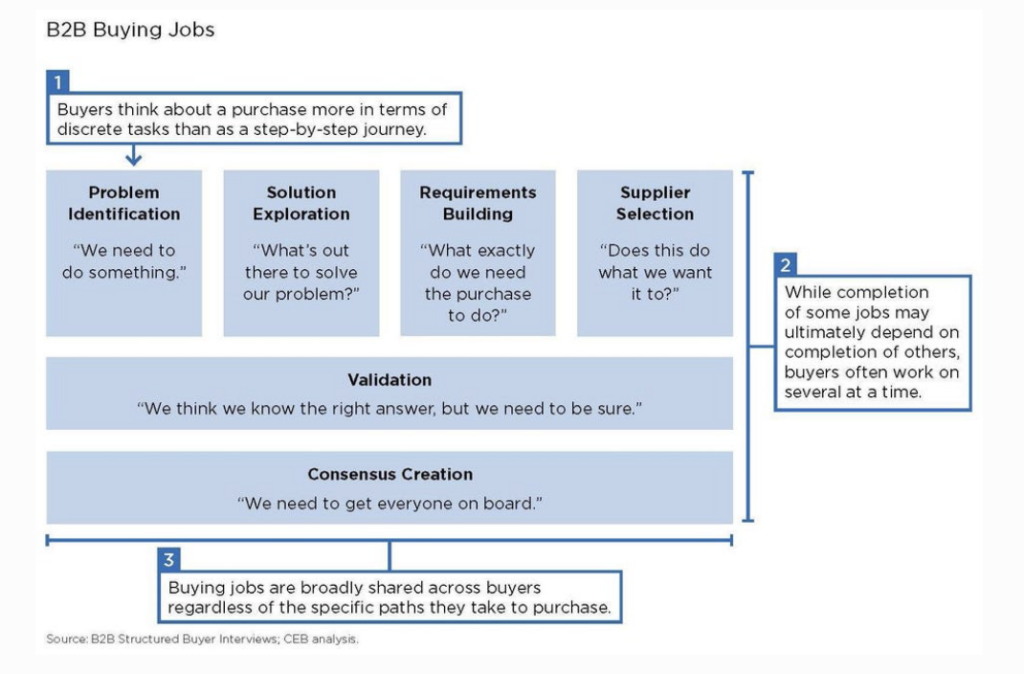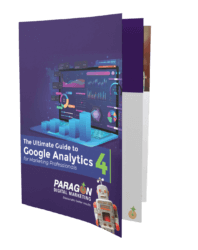Understanding your customer is key to effective marketing and ultimately, a successful business. It’s also important to understand what your customers need to know during different stages of their buyer’s journey, which includes: awareness, interest, consideration, and decision stages.
In this marketer’s guide, we’ll share information about each stage and what you should consider; common roadblocks, why the buyer’s journey isn’t always linear, and focusing on strategies that help you deliver the most helpful content to potential customers at the right time, which ultimately will help you win more customers.
What is the buyer’s journey?
The buyer’s journey describes the pathway a buyer takes; from becoming aware of your product or business to ultimately deciding to buy. As a general rule, buyers don’t suddenly see your business and make an impulse purchase, they go through a process of becoming aware of what you offer, evaluating it against other similar offers, and then making a decision to buy.

Your typical customer’s buyer journey might look quite different compared to a customer of a different business. Also, product purchase journeys, such as buying soap, a treadmill or a car, differ from service-oriented journeys, such as accounting or IT support. Typically, higher priced items and services have different sales processes and longer buyer journeys.
Why should you know your buyer’s journey?
Simply put, buyers have different needs and expectations at each stage of their buying journey. Knowing what your buyer’s journey looks like means that you can deliver the right messaging at the right time and respond appropriately to help the customer move to the next stage. You can be proactive about anticipating their needs and provide the answers they are looking for. Rather than pushing tactics, it’s more of a pull, providing expert guidance along the way to meet their immediate needs and questions and encourage them to take the next step if your product or service is right for them.

Buyer personas are important to reference
While identifying your buyer’s journey, it’s important to reference and be familiar with your buyer personas. You probably have at least two types of “ideal customers” for your business, and the buyer or customer persona describes them in detail. It outlines their goals, needs, problems, demographic information, job role, and more.
How does this relate to the buyer’s journey? You can learn a lot about the journey a buyer will take from their persona. For example, let’s say you sell a B2B service. The potential customers you interact with may not always be the final decision-maker responsible for approving the purchase. In that case, you’d need to provide them with service information, pricing, and other details that they’ll be sharing with the decision maker. You’d need to think about the needs of that person, too – what factors will help them in determining your solution is the best? At which point of the journey do they step in?
Understanding your customer is key to effective marketing and ultimately, a successful business. Share on XThe stages of the buyer’s journey
There are four main stages of the buyers journey:
Stage #1 – Awareness
In the awareness stage, the buyer becomes aware of two things:
- They have a problem that needs solving, and;
- Your business may have the solution to that problem.
The goal of the buyer at this stage is to find out more about their problem. The buyer hasn’t yet created a full picture of what their problem is or how to define it. This stage often includes research to find more information to clearly understand their issue.
For example, back pain is a common issue that affects many people. While it’s easy to become aware of, the cause of the pain isn’t always so obvious. People typically search online and ask friends or family members if they’ve experienced the same issue and what they’ve done in the past to remedy the pain. If you are a physical therapist or chiropractor, creating informational content that describes different types of back pain and some common causes is helpful for visitors during the awareness stage.
At this phase, it’s also important to consider how the buyer becomes aware that they have a problem. Something like pain is more urgent, however, what if it’s more about improving the way they do everyday tasks? What if they’re not even aware that they could be much more efficient, or doing something in a better way? If the buyer isn’t experiencing obvious symptoms, how do you help make them aware that there are easier solutions to a task that could save them time and money?
Some common marketing strategies at this stage are to provide resources that give the buyer information and to promote those resources via landing pages, social media, company websites, or PPC advertising. By providing valuable information to potential buyers and being useful, you start to build their trust in your business.
What sort of things should you consider at this stage? Here are some examples:
- Think about how the buyer would describe their problem and use similar language. This is typically how they will search for solutions.
- Consider where buyers are looking for information – how will they educate themselves? You can look to your buyer personas to get ideas about this and focus your efforts in the right places.
- Are there any common misconceptions about their problem? For example, if we think about the back pain example again, Alternative sentence – People may believe that prescription drugs or surgery are their only option to relieve pain, but if you are able to offer a less invasive or harmful solution such as physical therapy or massage therapy then you may be a more appealing option.
- What will be the most pressing hot buttons for the buyer when it comes to the problem? What will make them prioritize solving it? For example, someone with back pain might be concerned that they aren’t able to participate in their usual activities. Sharing content that prioritizes returning to sports, or playing with their children or grandchildren may be helpful.
Stage #2 – Interest
During the interest stage the buyer starts to gather information and perform the initial research. They are still trying to determine exactly what their problem is and how to solve it, and are most likely looking into different types of services that can approach the resolution of their problem in different ways.
Common actions performed during the interest stage include reading articles online and performing searches on Google that are relevant to their issue. They may also begin downloading guides that offer potential solutions.
If we’re using back pain as an example, customers will likely respond well to the unique selling propositions that they encounter during this initial research. A massage therapist might tout that they are a “non-invasive alternative to costly surgery” or “a side-effect free alternative to prescription medications.”
Stage #3 – Consideration
The consideration stage is when the buyer has a clear definition of their problem, and they’re now researching and considering different approaches to solving it. Someone with back pain might be asking, “how do I treat back pain?” Or, if they’ve worked out the cause of their problem it might be, “how to treat back pain caused by sitting.” Or, “how to treat back pain without medication.”
This is the stage at which you can create content containing approaches to solving the problem. A physical therapist might publish a quick guide, “5 Simple Exercises to Strengthen Your Back”; they will probably also talk about how a physical therapist can help with a personalized treatment plan.
What should marketers do here? It’s important to realize that buyers are weighing their options. They want to know how your product or service solves their problem compared to your competitors. It’s time to highlight your key points of difference and what makes your product a great choice. Not every buyer will be ideal for your business, so creating content that highlights different options and works for different buyer personas is key. Aiming to be as helpful as possible during this consideration phase will help buyers take the next step.
Some aspects to consider include:
- Know how buyers perceive the different types of solutions.
- What makes buyers decide that a type of solution is better-suited to them?
- Any concerns the buyer may have about solutions to their problem. (E.g., cost, convenience, effectiveness, pain…)
- Know how buyers prefer to learn about or research the different types of solutions.
- Social proof that buyers may look for, including ratings, testimonials and referrals.
- Any common pitfalls that customers should avoid as they seek to solve their problem.
Stage #4 – Decision
The decision stage is the point at which the buyer knows their problem and is already aware of your solution and your competitor’s options. They’re now ready to make a buying decision; but will they choose your product or service as the solution?
At this point, buyers are probably evaluating their choices. They may be weighing the pros and cons of each option. Or, someone who is not the final decision-maker may be required to prepare a shortlist of vendors and write up a comparison of each for the person who will ultimately decide.
As a marketer, you need to understand any hesitations or objections the buyer might have at this stage and work to minimize them. For example, if it’s “I’m not ready to commit to an annual plan right away,” your solution might be, “here is our 14-day free trial,” or, “here’s what we offer on a monthly plan or pay-as-you-go basis.”
This is also the phase to ensure you’ve honed a unique selling proposition so that prospective buyers see you as a clear choice, separate from competitors. This could be something related to how your solution is implemented. For example, if you sell office software, perhaps you assign a team member to help a business set it up correctly and to ensure a seamless transition.

Some key considerations for this phase include:
- Know how buyers compare or evaluate their possible solutions. What are the most important aspects to them?
- Know exactly how you are different from competitors (including any differences that might be counted as negatives).
- Know how you are similar to competitors – why should buyers choose you first?
- Understand any concerns buyers might have, along with the aspects they like.
- What expectations do buyers have? For example, is it typical in your industry that they should get a free trial or a risk-free return period?
- What else might be involved in the buyer’s decision? For example, implementation is important if you sell software or other solutions that will fundamentally change how they operate. Planning for training and including project and change management in your process will need to be considered.
Roadblocks in the buyer’s journey
What if you think you’ve neatly sorted out your buyer’s journey and created the content needed for each stage, only to find that customers aren’t buying? You may have one or more common roadblocks in the way:
Poor user experience
You can do as much marketing as you like, and probably spend a lot of money on those efforts, but if your website provides a poor user experience or makes it confusing or difficult to buy, you’ll lose potential customers. Your website design, page loading speeds, and functionality should all be optimized to provide the best possible experience to users. This also helps them form a better impression of your business!
Inconsistent branding
Everything about your brand – your voice, imagery, and messaging – should be consistent across every interaction with potential and current customers. Inconsistency confuses people and can muddle the message you are trying to communicate. When people are confused, they’re unlikely to buy.
Poor quality content
Your aim with content is to be as helpful as possible while creating a good impression of your business. Poor research, spelling and grammatical errors, lack of formatting, or the use of poor-quality imagery can send the wrong message. If you’re going to create it, make it the best possible quality you can!
Missing proof
Many customers place high value in current and past customer reviews and testimonials. In addition to ratings found within online review platforms, providing direct feedback from customers who like and appreciate your products and services on your website and other channels is a great way to build social proof.
No clear benefits to the customer
A buyer is always looking to answer, “what’s in it for me?” They need clear links between the problem they have and the benefits to them choosing your solution. Sometimes marketers make the mistake of giving a lot of detail about features but miss how those features convey a benefit to the customer. You need to spell this out clearly – people aren’t always going to look in-depth or read between the lines!
Why the buyer’s journey isn’t always linear
The buyer’s journey model tends to make it seem like the whole thing is tidy and linear. The truth is, the journey is often not linear at all. For instance, a customer might drop in at any stage – finding a solution before they were even aware they had a problem.
Forbes reported on research from Gartner confirming the buyer’s journey is rarely linear. In the B2B world, they found that the customer journey is broken down as a set of jobs to be done and that the buyer will typically go in and out of each of those jobs, rather than following a linear path.

Whether customers move through linearly or not, they need to fulfill those jobs by searching for and finding information. For marketers, this highlights the importance of ensuring you have content that provides solutions for every stage of the journey. Skipping a step means the buyer may have missed out on needed information.
Final thoughts
The buyer’s journey is a key factor in understanding the most effective or appropriate means of reaching the customer at any given stage. For marketers, it’s about matching up the content or campaigns you produce with the needs of the customer.
Following the buyer’s journey promotes a more gentle and useful approach to marketing. It’s not about the more aggressive tactics of the past – it’s about building a relationship with prospects based on trust and usefulness.
Identifying your buyer’s journey will change how you look at marketing, and we hope it will impact your results positively, too! If you need support, reach out to us today – our experienced team is happy to help.
Read more on the buyer’s journey: How to Get Your Messaging Right at Each Stage of the Buyer’s Journey


